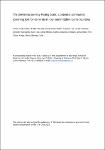The Dementia Severity Rating Scale: a potential community screening tool for dementia in low- and middle-income countries
| dc.contributor.author | Turana, Y | |
| dc.contributor.author | Farina, N | |
| dc.contributor.author | Theresia, I | |
| dc.contributor.author | Fitri, FI | |
| dc.contributor.author | Suswanti, I | |
| dc.contributor.author | Jacobs, R | |
| dc.contributor.author | Schneider, M | |
| dc.contributor.author | Sani, TP | |
| dc.contributor.author | Comas-Herrera, A | |
| dc.contributor.author | Albanese, E | |
| dc.contributor.author | Govia, I | |
| dc.contributor.author | Ferri, CP | |
| dc.contributor.author | Knapp, M | |
| dc.contributor.author | Banerjee, S | |
| dc.date.accessioned | 2023-09-01T11:33:45Z | |
| dc.date.available | 2023-09-01T11:33:45Z | |
| dc.date.issued | 2023-12-14 | |
| dc.identifier.issn | 1471-3012 | |
| dc.identifier.issn | 1741-2684 | |
| dc.identifier.uri | https://pearl.plymouth.ac.uk/handle/10026.1/21274 | |
| dc.description.abstract |
Background The Dementia Severity Rating Scale (DSRS) is an informant report, dementia staging tool that is quick to administer and has previous been shown to differentiate between people with dementia and healthy controls. However, it is not clear how accurate the tool is screening against diagnostic criteria in middle-income settings. Methods Embedded within the STRiDE programme, older adults (aged ≥65 years) and their informants were randomly recruited from four sites across Indonesia and South Africa. All informants were asked to complete DSRS. We report the tool’s psychometric properties and accuracy against the 10/66 short diagnostic algorithm. Results Between September and December 2021, data was collected from 2110 older adults in Indonesia and 408 in South Africa. Overall, the DSRS scores significantly differed between those with and without dementia, as identified on the 10/66 short algorithm (p < .05). The difference between groups remained significant after controlling for key factors related to older adult and informant demographics. A score >2 on the DSRS had the greatest agreement with the 10/66 short algorithm and had excellent discriminative properties in both Indonesia (Area Under Curve (AUC) = .75, 95% CIs = .72–.77) and South Africa (AUC = .82, 95% CIs = .76–.88). Conclusions The DSRS has potential as a screening tool for dementia in middle-income countries, with high sensitivity and specificity against a standardized diagnostic algorithm. | |
| dc.format.extent | 476-492 | |
| dc.format.medium | Print-Electronic | |
| dc.language | en | |
| dc.publisher | SAGE Publications | |
| dc.subject | dementia | |
| dc.subject | dementia severity rating scale | |
| dc.subject | older adults | |
| dc.subject | screening tools | |
| dc.title | The Dementia Severity Rating Scale: a potential community screening tool for dementia in low- and middle-income countries | |
| dc.type | journal-article | |
| dc.type | Article | |
| plymouth.author-url | https://www.ncbi.nlm.nih.gov/pubmed/38096489 | |
| plymouth.issue | 3 | |
| plymouth.volume | 23 | |
| plymouth.publisher-url | http://dx.doi.org/10.1177/14713012231186837 | |
| plymouth.publication-status | Published | |
| plymouth.journal | Dementia: The International Journal of Social Research and Practice | |
| dc.identifier.doi | 10.1177/14713012231186837 | |
| plymouth.organisational-group | |Plymouth | |
| plymouth.organisational-group | |Plymouth|Faculty of Health | |
| plymouth.organisational-group | |Plymouth|Users by role | |
| plymouth.organisational-group | |Plymouth|Users by role|Academics | |
| plymouth.organisational-group | |Plymouth|Faculty of Health|Peninsula Medical School | |
| dc.publisher.place | England | |
| dcterms.dateAccepted | 2023-06-18 | |
| dc.date.updated | 2023-09-01T11:33:44Z | |
| dc.rights.embargodate | 2024-1-3 | |
| dc.identifier.eissn | 1741-2684 | |
| rioxxterms.versionofrecord | 10.1177/14713012231186837 |


